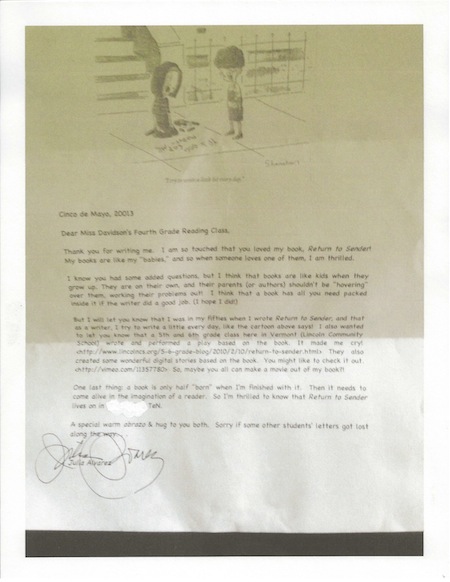By Jeanne Gilliam Fain & Christina Davidson
We waited anxiously for a response on Facebook and promptly learned that Julia Alvarez requested a letter sent in the mail. Julia Alvarez graciously answered many of the students’ questions. As educators, it was our goal for the students to step outside of their local world and think globally about their presence within the world. We hope that students learn to understand, question, and improve the world. For us, literature helped the students to see disruption of their views, multiple viewpoints, the sociopolitical, and how their actions can make a difference in their world. This work had bumps, U-turns, uphill, and downhill responses. Julia Alvarez, in her letter, encouraged the students to think about the role of the reader and the imagination he/she has within the interaction with a text.

We learned from the students that critical views of literature have to begin with what students know. We noticed that literature with strategic and intentional discussion and multiple invitations help students notice new meanings and understand the world around them.
References:
Alvarez, J. (2009). Return to Sender. New York, NY: Yearling.
Hopkinson , D. (2005). Saving Strawberry Farm. New York, NY: Greenwillow Books.
Vasquez, V.M., Tate, S.L., and Harste, J.C. (2013). Negotiating Critical Literacies with Teachers: Theoretical Foundations and Pedagogical Resources for Pre-service and In-service Contexts. New York, NY: Routledge.
Woodson, J. (2001). The Other Side. New York, NY: GP Putnam’s Sons.
Woodson, J. (2012). Each Kindness. New York, NY: Nancy Paulsen Books.
Journey through Worlds of Words during our open reading hours: Monday-Friday, 9 a.m. to 5 p.m. and Saturday, 9 a.m. to 1 p.m. To view our complete offerings of WOW Currents, please visit archival stream.
- Themes: Christina Davidson, Jeanne Gilliam Fain
- Descriptors: Student Connections, WOW Currents
